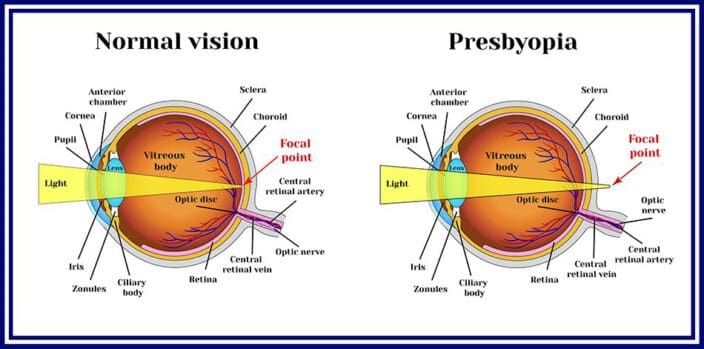
Medically Reviewed by Duna Raoof, M.D. NVISION Surgeon
Corneal Inlay Surgery: Costs, How It Works & Expectations
Last Updated:

Medically Reviewed by Duna Raoof, M.D. NVISION Surgeon
Corneal inlay surgery is when a tiny device (a corneal inlay) is surgically implanted into the eye. These devices can increase your depth of focus, which can make it easier to read and look at other things up close. The 15-minute procedure is fairly safe but not totally without risk.
Table of Contents
This procedure is generally for people with presbyopia, a condition common among people in their 40s and 50s as the eyes’ lenses harden, making it difficult to focus on things up close. Often, corrective glasses or contacts can help people with this condition see better. Always consider the risks and benefits of surgery over corrective wear before making a decision.
Corneal inlays cost an average of $4,000 to $5,000 for most people to get implanted.
This treatment option is not going to work for everyone. To be a good candidate, your eyes generally need to be otherwise healthy besides your presbyopia. A variety of eye conditions, such as cataracts, can bar you from corneal inlays. Some conditions, like myopia, may require that you first get corrective surgery before you can get a corneal inlay.

If you are disappointed with the results, these implants are reversible, barring major issues. Any surgery, even one to reverse your inlay, carries some risk.
Discuss whether a corneal inlay is right for you with your doctor. There are benefits and downsides to procedure, and it is moderately expensive. At the same time, the procedure is FDA-approved and not especially risky. It can help many people gain the ability to read and do other activities that involve close-up detail they may have lost with age.
Corneal Inlay Surgery
Corneal inlays are tiny devices that are surgically placed in the middle of the cornea of the nondominant eye. The implant can help to correct close-up vision, increasing depth of focus. This can improve one’s ability to read or look at other things up close, such as phones.
There are two types of corneal inlays, only one of which is approved by the FDA at this time.
You deserve clear vision. We can help.
With 135+ locations and over 2.5 million procedures performed, our board-certified eye surgeons deliver results you can trust.
Your journey to better vision starts here.
- Refractive corneal inlays: This type of inlay has different layers that have different levels of magnification. This can let the eye focus both up close and far away. This procedure is under review by the FDA, so it is not currently available.
- Small aperture inlays: Like the aperture of a camera, an aperture inlay works by controlling how much light enters the eye. The device looks like a ring, with an opening in the center. KAMRA is the first of such devices to be approved by the FDA. If you receive corneal inlay surgery at this time, it is very likely this device will be put in your eye.
The surgery takes approximately 15 minutes. You will be conscious for it but under local anesthesia so it should not be painful. The device will be implanted in only your nondominant eye.
Who Can Benefit?
Corneal inlays are not an ideal solution for all vision problems.
Generally, they are used to treat presbyopia, a relatively common eye condition for those in their 40s and 50s. Presbyopia is a normal part of aging. It is caused by the lens in your eye becoming more rigid. This makes it more difficult for your eye to focus up close.
Corneal inlay surgery is one of several options to treat presbyopia. Glasses and contacts can also be used to facilitate reading and other up-close visual needs. You and your doctor can make the choice of which is best for your situation.

Cost & Limitations
While the cost of a surgery can vary significantly, a corneal inlay will generally cost about $4,000 to $5,000 to get implanted. Insurance may cover the procedure. Check your specific policy for coverage specifics.
Corneal inlays require you have otherwise fairly healthy eyes beyond your presbyopia. You will need to be free of diseases of the cornea and cataracts. You also cannot have uncontrolled dry eyes or blepharitis.
Refractive errors like myopia, hyperopia, or astigmatism present a more complicated picture. While corneal inlays alone cannot be used if you have these conditions, these conditions can sometimes be treated in a combination procedure.
First, LASIK is used to fix the refractive error, and then, the inlay is implanted. This is sometimes considered off-label use of corneal inlays, but such use is still permitted by the FDA if a doctor is trained and knowledgeable on the devices and procedures used.
There are few options available to choose from when it comes to FDA-approved corneal inlay surgery. There were previously two approved devices: the KAMRA and Raindrop corneal inlays. However, as of January 30, 2018, the company that manufactured the Raindrop corneal inlays, ReVision Optics, went out of business and is no longer selling the devices.
You deserve clear vision. We can help.
With 135+ locations and over 2.5 million procedures performed, our board-certified eye surgeons deliver results you can trust.
Your journey to better vision starts here.
What Should I Expect After the Procedure?
After your surgery, follow the instructions given to you by your doctor carefully. You will have to use antibiotic and steroid eye drops for at least a month, to reduce the risk of complications as the eye heals from the surgery.
The following are potential complications that can occur after the surgery:
- Infection
- Reduced quality of vision
- Glare or halos around lights
- Night vision problems
- Fluctuating vision
- Blurriness
If you experience any of these complications, discuss them with your ophthalmologist. If you are not happy with your inlay, barring severe complications, they can be removed.
Are Corneal Inlays Worth the Risk & Cost?

While certainly not inexpensive, a corneal inlay’s ability to potentially give you the ability to read without glasses or contacts is a big selling point for many. Still, some patients who receive these inlays end up needing glasses for certain tasks.
The surgery is not totally without risk, even if it is a fairly quick and generally reversible procedure. As with any eye surgery, complications can lead to serious eye damage. Talk to an ophthalmologist about these risks before making a decision.
Whether a corneal inlay is worth the risk and cost largely comes down to specifics of your situation. If you value your ability to see up-close details and are experiencing a serious drop in your quality of life as this ability fades, talk to your doctor about this option. While moderately expensive, it is considered a safe procedure with many benefits.
You deserve clear vision. We can help.
With 135+ locations and over 2.5 million procedures performed, our board-certified eye surgeons deliver results you can trust.
Your journey to better vision starts here.
References
- Corneal Inlays: A Surgical Alternative to Reading Glasses. (May 23, 2019). American Academy of Ophthalmology.
- What Is Presbyopia? (February 21, 2019). American Academy of Ophthalmology.
- Update on Corneal Inlays for Presbyopia. (February 2016). Review of Ophthalmology.
- ReVision Optics Goes Out of Business. (February 1, 2018). Eyewire News.
- Comparison of FDA Safety and Efficacy Data for KAMRA and Raindrop Corneal Inlays. (September 18, 2017). International Journal of Ophthalmology.

Dr. Raoof is a fellowship-trained and board-certified cataract, cornea and LASIK surgeon. She is a highly acclaimed ophthalmologist and influential surgeon in the eye care industry.
This content is for informational purposes only. It may have been reviewed by a licensed physician, but is not intended to serve as a substitute for professional medical advice. Always consult your healthcare provider with any health concerns. For more, read our Privacy Policy and Editorial Policy.
